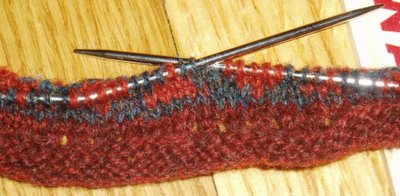Komi, take 2
I started knitting the Komi sweater. At first, it seemed to be going well. I knit a facing. I knit a picot turning row. Then I started to knit a border. I decided to bring in another color (and pattern) in the border, so the background of the border will be blue. I thought it was looking good. 
Then I started to suspect that maybe it was a bit too big around. I spread it out on a few needles, and this is what I saw:
yes, that is the 23 inch mark that my sweater start reaches. That means that the sweater would be at least 46 inches around. More careful measuring (with a tape measure, going around the curve) indicated that if I kept knitting I would end up with a sweater that was 50 inches around. I was aiming for about 40 inches around. 10 inches makes a big difference. Even after my carefully measured gauge swatch, my gauge was very different than I thought it was. I think it has something to do with the swatch being knitted on double pointed needles, and the sweater being knitted on a circular needle. I can't imagine what else could account for such a difference in gauge. This is why I often don't do a gauge swatch. If I'm going to rip out my first try anyway, I might as well not waste time knitting a swatch.
I did a bit of recalculation taking into account my new gauge, and I cast on again. The good news is that instead of knitting on 360 stitches, I now only have 288. It does go a little bit faster now. And I am almost back to the point where I noticed this little problem.
To answer some questions:
1. "Komi" refers to the ethnic group that designed the color pattern I am using. The Komi are a Finno-Ugric ethnic group that lives in European Russia near the arctic circle. Their knitting patterns are, in some ways, related to those of other Finno-Ugric groups (For example, the Estonians). However, they also have some unique qualities. Because these patterns were passed down from generation to generation without writing, they are very easy to learn and to remember. They consist of lines that are three stitches wide. The lines move over by one stitch on every row. Also, every third row is *knit 3 with color A, knit 3 with color B; repeat from *. To the best of my knowledge, the only English language book that describes these patterns is Charlene Schurch's Knitting Marvelous Mittens.
2. The yarn I am using is some Jamieson's Shetland jumperweight wool that I have had in my stash for a while. I am supplementing it with a few skeins of Jamieson and Smith Shetland jumperweight wool in a color that complements the ones I already had. The new wool arrived yesterday, and it looks great with the other colors. I can't wait to start knitting it!
3. I haven' t made a lot of decisions about this project yet. It will be a pullover, but I'm not sure what construction I'll use. It will definitely be knit entirely in the round. I may use steeks, or I may knit it in one piece from the bottom up with set-in sleeves. I used the one piece technique once before, and it worked pretty well (other than a slight sizing issue). And I would prefer to avoid all the effort of steeks if I can. It will all depend on how similar my stitch gauge and row gauge are.

3 Comments:
Betrayed by the gauge swatch, ugh! Well, at least you found out fairly early in the game. I usually knit sleeves first for that exact reason.
Thanks for the explanation about Komi!
It's looking great! I love the colors and the pattern.
Beautiful colors! Can't wait to see it. Your explanation of Komi really makes one think... what kinds of designs could be set up within those constraints... thanks for the book link.
Post a Comment
<< Home